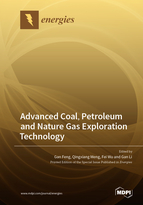Advanced Coal, Petroleum and Nature Gas Exploration Technology
A special issue of Energies (ISSN 1996-1073). This special issue belongs to the section "H1: Petroleum Engineering".
Deadline for manuscript submissions: closed (23 April 2023) | Viewed by 20950
Special Issue Editors
Interests: rock mechanics; geothermal exploitation; shale gas exploitation
Special Issues, Collections and Topics in MDPI journals
Interests: multiscale analysis; rock mechanics; numerical simulation
Special Issues, Collections and Topics in MDPI journals
Interests: rock mechanics
Special Issues, Collections and Topics in MDPI journals
Interests: soft rock support; numerical simulation; tunnel support
Special Issues, Collections and Topics in MDPI journals
Special Issue Information
Dear Colleagues,
Greetings from the guest editors of the Energies Special Issue on “Advanced Coal, Petroleum and Nature Gas Exploration Technology”.
We cordially invite you to submit your high-quality manuscripts to the Special Issue of the journal Energies on advanced coal, petroleum, and nature gas exploration technology. This Special Issue will cover a broad range of topics concerning coal, petroleum, nature gas, coalbed methane, shale oil, combustible ice, and other fossil energy, including exploration, reservoir characterization, machine learning applications, well logging, and geological aspects, and approach those topics from both an exploration and a production standpoint. We invite papers on innovative technical developments, reviews, case studies, as well as analytical and assessment papers from different disciplines that are relevant to the topic.
Dr. Gan Feng
Prof. Dr. Qingxiang Meng
Prof. Dr. Fei Wu
Dr. Gan Li
Guest Editors
Manuscript Submission Information
Manuscripts should be submitted online at www.mdpi.com by registering and logging in to this website. Once you are registered, click here to go to the submission form. Manuscripts can be submitted until the deadline. All submissions that pass pre-check are peer-reviewed. Accepted papers will be published continuously in the journal (as soon as accepted) and will be listed together on the special issue website. Research articles, review articles as well as short communications are invited. For planned papers, a title and short abstract (about 100 words) can be sent to the Editorial Office for announcement on this website.
Submitted manuscripts should not have been published previously, nor be under consideration for publication elsewhere (except conference proceedings papers). All manuscripts are thoroughly refereed through a single-blind peer-review process. A guide for authors and other relevant information for submission of manuscripts is available on the Instructions for Authors page. Energies is an international peer-reviewed open access semimonthly journal published by MDPI.
Please visit the Instructions for Authors page before submitting a manuscript. The Article Processing Charge (APC) for publication in this open access journal is 2600 CHF (Swiss Francs). Submitted papers should be well formatted and use good English. Authors may use MDPI's English editing service prior to publication or during author revisions.
Keywords
- unconventional resources
- reservoir characterization
- enhanced oil recovery
- multiphase flow
- numerical simulation
- energy efficiency
- petroleum geology
- hydraulic fracturing









